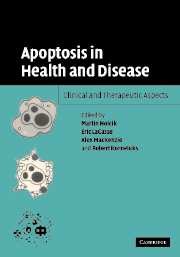Book contents
- Frontmatter
- Contents
- List of contributors
- Preface
- 1 Apoptosis in health, disease, and therapy: overview and methodology
- 2 Developmental apoptosis in health and disease
- 3 Apoptosis and cancer
- 4 Neuronal cell death in human neurodegenerative diseases and their animal/cell models
- 5 Apoptosis in the cardiovascular system: incidence, regulation, and therapeutic options
- 6 Cytotoxic lymphocytes, apoptosis, and autoimmunity
- 7 Pro- and anti-apoptotic strategies of viruses
- Index
- Plate section
- References
1 - Apoptosis in health, disease, and therapy: overview and methodology
Published online by Cambridge University Press: 03 March 2010
- Frontmatter
- Contents
- List of contributors
- Preface
- 1 Apoptosis in health, disease, and therapy: overview and methodology
- 2 Developmental apoptosis in health and disease
- 3 Apoptosis and cancer
- 4 Neuronal cell death in human neurodegenerative diseases and their animal/cell models
- 5 Apoptosis in the cardiovascular system: incidence, regulation, and therapeutic options
- 6 Cytotoxic lymphocytes, apoptosis, and autoimmunity
- 7 Pro- and anti-apoptotic strategies of viruses
- Index
- Plate section
- References
Summary
Introduction: life cannot exist without cellular death
Apoptosis, or programmed cell death, is the mechanism by which most cells die both physiologically and pathologically. The realization in the mid 1980s that cells die by an active, genetically defined process changed not only our views on cellular life but led to a whole new discipline of biologic study with significant implications for medicine (Thompson, 1995; Robertson et al., 2002). Apoptosis research has advanced our understanding of a basic cellular process, shed insight into many diseases, and is poised to affect the future practice of medicine by the introduction of therapies targeting this cell death process.
In this book, the term “apoptosis” is used synonymously, for right or wrong, with programmed cell death (PCD). While PCD may be a more appropriate term, encompassing all forms of active physiological cell death, apoptosis, which is defined morphologically and biochemically, is used here for historical purposes (Lockshin and Zakeri, 2002; Melino, 2002; Sloviter, 2002). The original “anatomical” characteristics of apoptosis were noted in the nineteenth century (reviewed in Clarke and Clarke, 1996; Rich et al., 1999). However, it was not until publications in 1951 and in the 1960s described developmental cell death or “shrinkage necrosis” that the PCD concept was recognized, re-introduced, and formalized (Lockshin and Zakeri, 2001; Kerr, 2002; Vaux, 2002). The term “apoptosis” was coined in 1972, referring to this morphologically defined form of cell death (Kerr et al., 1972).
- Type
- Chapter
- Information
- Apoptosis in Health and DiseaseClinical and Therapeutic Aspects, pp. 1 - 48Publisher: Cambridge University PressPrint publication year: 2005
References
- 3
- Cited by



